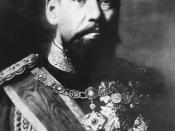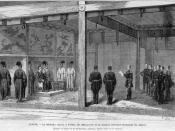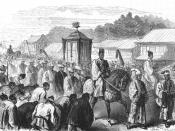In the early 19th century, Japan had existed in a state of isolation for over 200 years. This isolation generated a rigid society accessorised with traditions and values that governed the Japanese way of life. 1868 saw the fall of the Tokugawa Shogunate and the rise to power of the Emperor Meiji. Japan was then under political control of the Emperor, or rather his ÃÂadvisors,ÃÂ a group of samurai aristocrats that went on to create a new system of government, law and education, and reshaped the military and society itself. The leaders also imposed an Emperor ideology on the public, so that support and justification could be established throughout Japanese society. These radical and sudden changes resulted in tension and strain on original Japanese tradition and this was reflected in the public dissatisfaction and unrest over the government-implemented reforms. The transformation of Japanese society was essentially inspired by the challenge presented by the Western World and it was the way in which the Japanese answered this challenge and how their traditions were affected that defined this period in Japanese history.
The Japanese leaders intended not to Westernise, but to modernise. The leaders did not propose to sacrifice or change fundamentally ÃÂthe spirit of Old Japan,ÃÂ (Morton, 1994) or the soul of the nation, only to borrow certain ideas from other cultures that could be put into use to modernise and revise existing Japanese civilisation. They essentially decided to select the best model in each field of technology and administration which would make Japan a powerful match for other nations, the national goal at that time. Essentially, there was a struggle between the want to modernise and to keep original Japanese tradition. Emperor MeijiÃÂs advisors intended to replace old clan loyalties with a sense of national identity and...


